SF32LB56-DevKit-LCD Development Board User Guide¶
Overview of the Development Board¶
The SF32LB56-DevKit-LCD is a development board based on the SF32LB56xV series module, primarily used for developing various applications with displays that use MIPI-DPI/SPI/DSPI/QSPI or MIPI-DBI(MCU/8080) interfaces.
The development board also features an analog MIC input, analog audio output, SDIO interface, USB-C interface, and supports TF cards, providing developers with a rich set of hardware interfaces. This helps developers simplify the hardware development process and reduce the time to market for their products.
The appearance of the SF32LB56_DevKit-LCD is shown in Figure 1 and Figure 2.
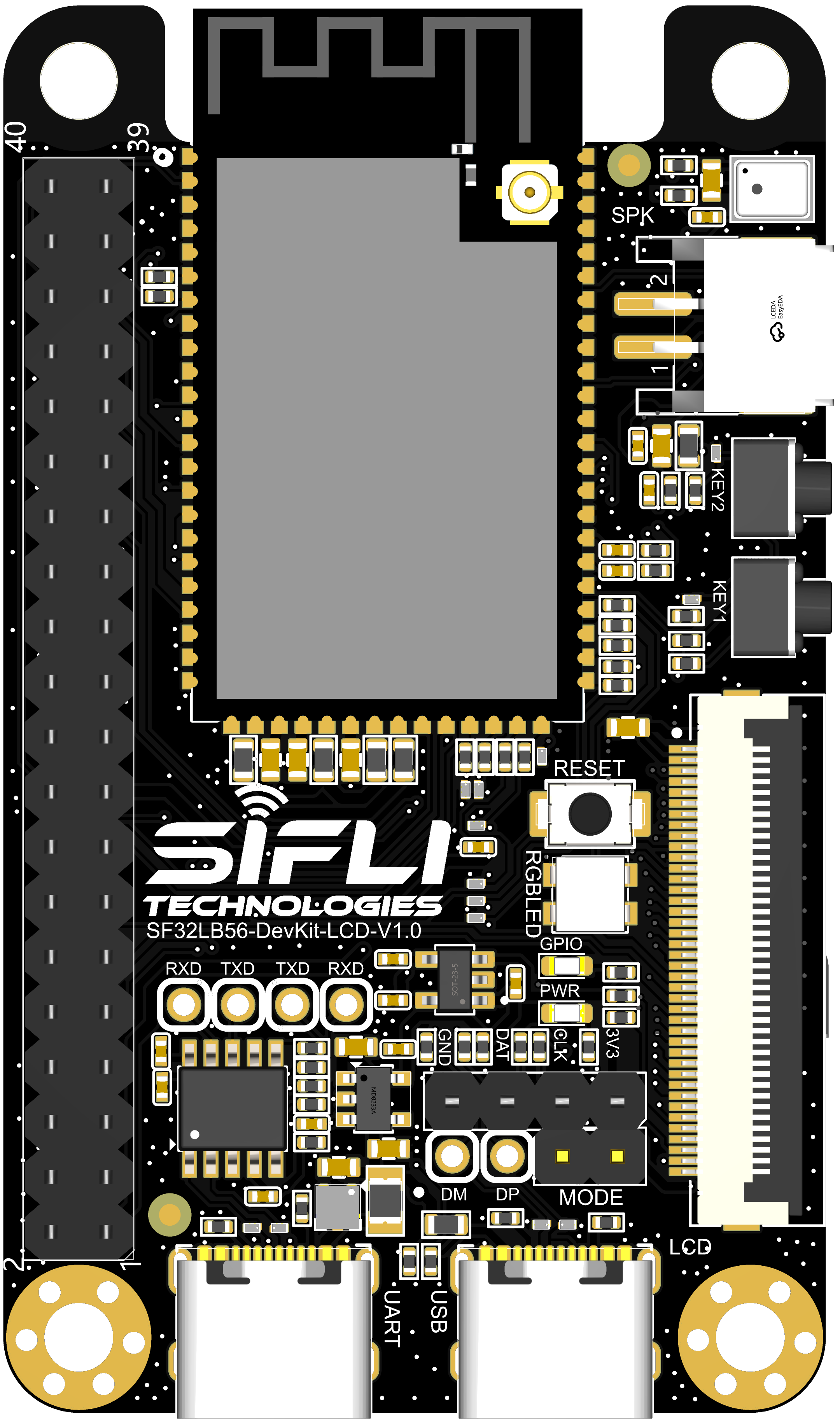
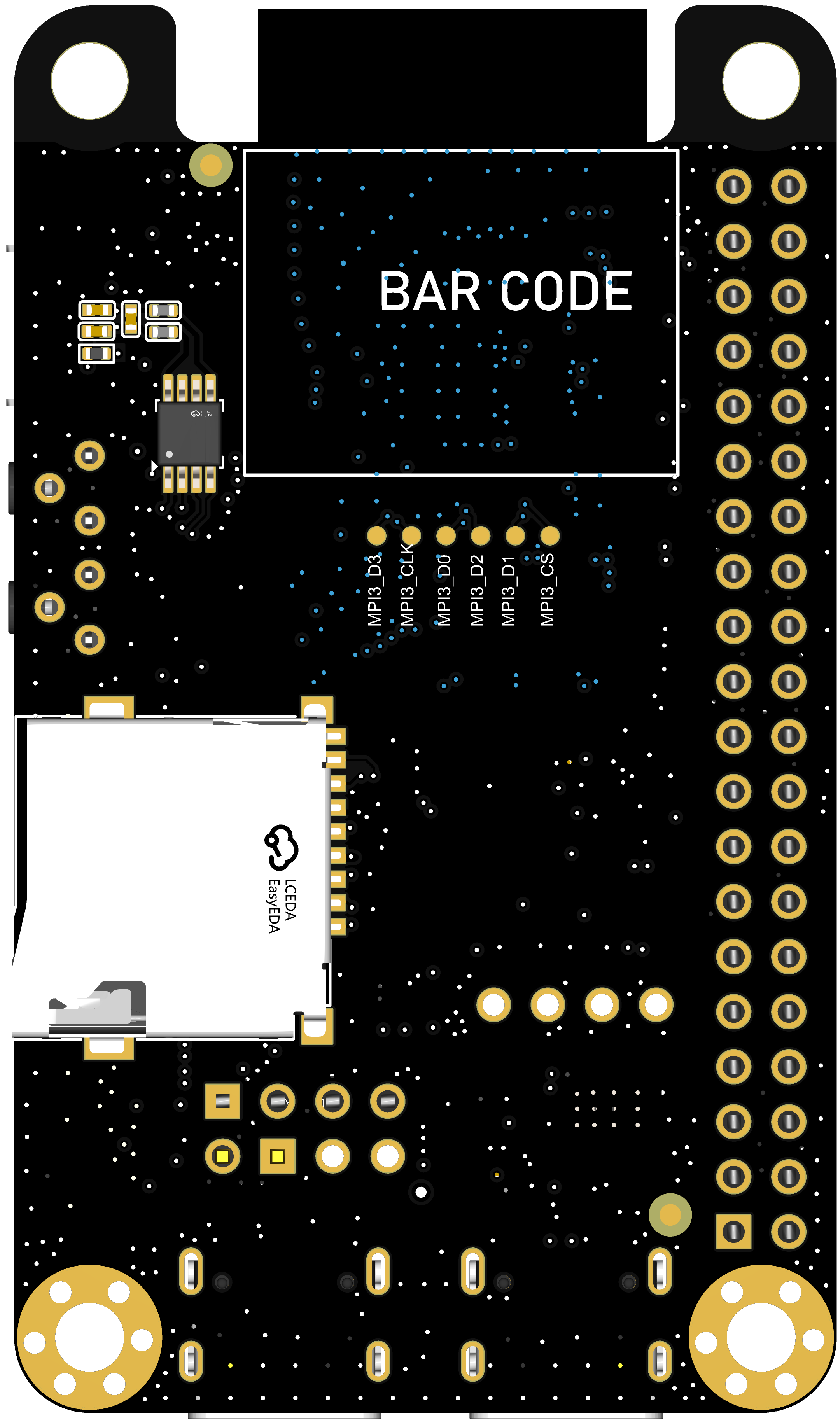
Feature List¶
The development board has the following features:
Module: Equipped with the SF32LB56-MOD-A128R12N1 module based on the SF32LB56xV chip, with the following configuration:
Standard configuration: SF32LB566VCB36 chip, with the following integrated components:
8MB OPI-PSRAM, interface frequency 144MHz (subject to change upon official release)
4MB OPI-PSRAM, interface frequency 144MHz (subject to change upon official release)
1Gb QSPI-Nand Flash, interface frequency 72MHz, STR mode (subject to change upon official release)
48MHz crystal
32.768KHz crystal
On-board antenna or IPEX antenna connector, selectable via 0Ω resistor, default is on-board antenna
RF matching network and other passive components
Dedicated screen interfaces
MIPI-DPI, supports 40-pin FPC connector for the Olimex 40-pin pinout
SPI/DSPI/QSPI, supports DDR mode QSPI, exposed via 40-pin header
8bit MCU/8080, exposed via 40-pin header
Supports I2C interface touch screen
Audio
Supports analog MIC input
Analog audio output, with on-board Class-D audio PA
USB
Type C interface, supports on-board USB to UART chip for program download and software debugging, can provide power
Type C interface, supports USB2.0 FS, can provide power
SD Card
Supports SDIO interface TF card, with on-board Micro SD card slot
Functional Block Diagram¶
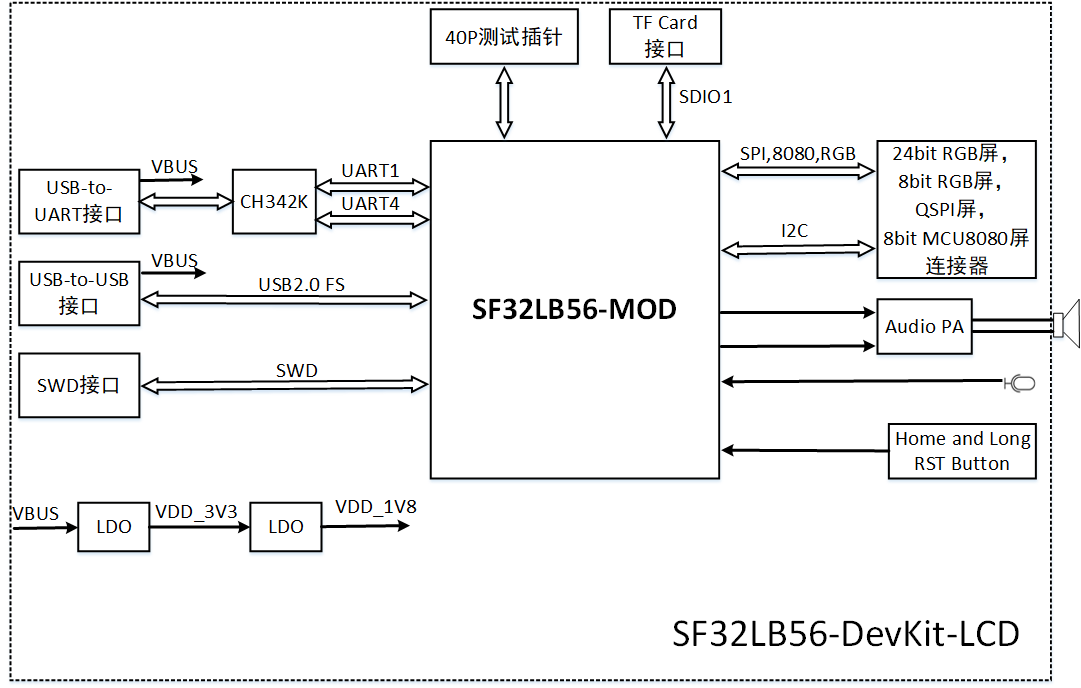
Component Introduction¶
The main board of the SF32LB56-DevKit-LCD development board is the core of the entire kit. This main board integrates the SF32LB56-MOD-A128R12N1 module and provides an MIPI-DPI (RGB-24bit) LCD connector.
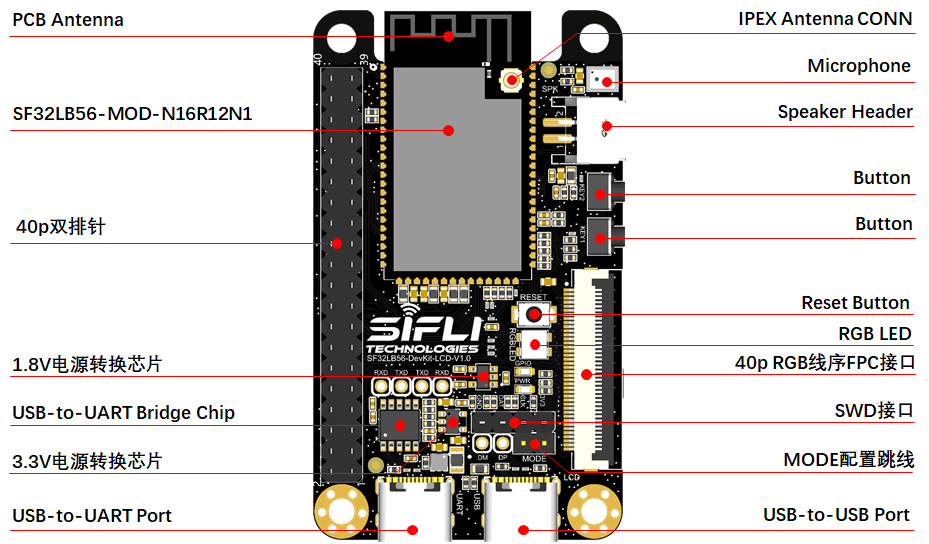
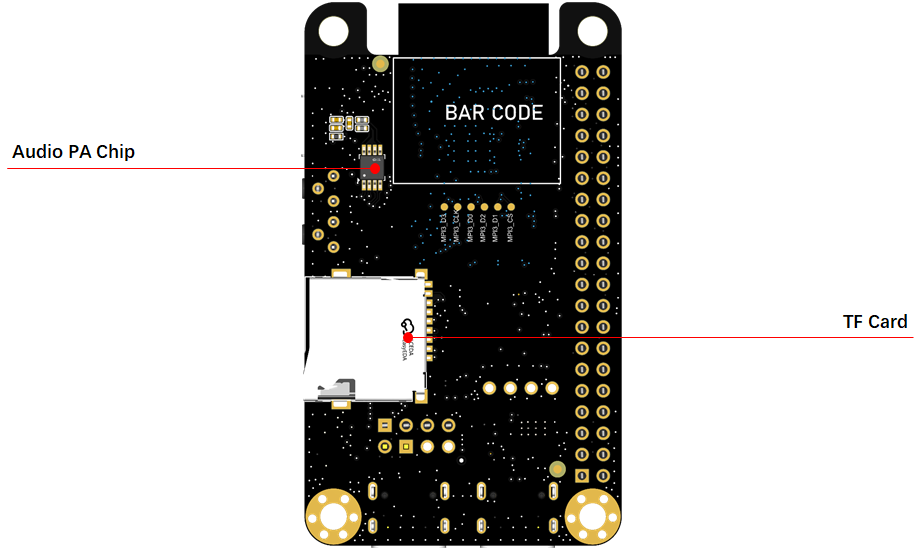
Application Development¶
This section mainly introduces the setup methods for hardware and software, as well as the instructions for burning firmware to the development board and developing applications.
Required Hardware¶
1 x SF32LB56-DevKit-LCD (including SF32LB56-MOD-A128R12N1 module)
1 x Screen module
1 x USB2.0 data cable (Standard A to Type-C)
1 x SWD debugger
1 x Computer (Windows, Linux, or macOS)
Note
If you need to use both UART debugging and the USB interface, you will need two USB2.0 data cables;
Ensure you use the appropriate USB data cable, as some cables are only suitable for charging and cannot be used for data transfer or firmware burning.
Optional Hardware¶
1 x Speaker
1 x TF Card
1 x 450mAh Lithium Battery
Hardware Setup¶
Prepare the development board and load the first example application:
Connect the screen module to the corresponding LCD connector interface;
Open the SifliTrace tool software from Sicheng, and select the correct COM port;
Insert the USB data cable to connect the PC to the USB to UART port of the development board;
The screen should light up, and you can interact with the touch screen using your fingers.
Once the hardware setup is complete, you can proceed to the software setup.
Software Setup¶
For the SF32LB56-DevKit-LCD development board, refer to the relevant software documentation for a quick setup of the development environment.
Hardware Reference¶
This section provides more information about the hardware of the development board.
GPIO Allocation List¶
The table below lists the GPIO allocation for the SF32LB56-MOD-A128R12N1 module, used to control specific components or functions of the development board.
Pin |
Pin Name |
Function |
|---|---|---|
1 |
GND |
Ground |
2 |
PB_22 |
Touchscreen reset signal |
3 |
PA_47 |
MIPI-DPI(RGB) DE, LCD interface signal |
4 |
PA_42 |
MIPI-DPI(RGB) VSYNC, LCD interface signal |
5 |
PA_44 |
MIPI-DPI(RGB) HSYNC, LCD interface signal |
6 |
PB_17 |
UART4_TXD, default print port of BOOTROM and small core software debugging interface |
7 |
PB_16 |
UART4_RXD, default print port of BOOTROM and small core software debugging interface |
8 |
PA_45 |
MIPI-DPI(RGB) CLK, LCD interface signal |
9 |
PA_46 |
MIPI-DPI(RGB) B7, LCD interface signal |
10 |
PA_18 |
USB_DM |
11 |
PA_17 |
USB_DP |
12 |
PA_40 |
MIPI-DPI(RGB) B6, MCU 8080 DIO0, QSPI DIO2, E-Paper SDI, LCD interface signal |
13 |
PA_39 |
MIPI-DPI(RGB) B5, MCU 8080 DC, QSPI DIO1, E-Paper DC, LCD interface signal |
14 |
PB_32 |
HOME and long press reset button |
15 |
PA_51 |
Touchscreen interrupt INT |
16 |
PA_41 |
MIPI-DPI(RGB) B4, MCU 8080 DIO1, QSPI DIO3, LCD interface signal |
17 |
PA_43 |
MIPI-DPI(RGB) B3, LCD interface signal |
18 |
PA_38 |
MIPI-DPI(RGB) B2, MCU 8080 RD, QSPI DIO0, LCD interface signal |
19 |
PA_37 |
MIPI-DPI(RGB) B1, MCU 8080 WR, QSPI CLK, E-Paper CLK, LCD interface signal |
20 |
PA_36 |
MIPI-DPI(RGB) B0, MCU 8080 CS, QSPI CS, E-Paper CS, LCD interface signal |
21 |
PA_35 |
MIPI-DPI(RGB) G7, LCD interface signal |
22 |
PA_31 |
MIPI-DPI(RGB) G6, MCU 8080 DIO5, LCD interface signal |
23 |
PA_29 |
MIPI-DPI(RGB) G5, MCU 8080 DIO3, LCD interface signal |
24 |
PA_34 |
MIPI-DPI(RGB) G4, MCU 8080 DIO7, LCD interface signal |
25 |
BOOT_MODE |
BOOT_MODE signal, =1 download mode; =0 user program mode |
26 |
VDD |
Main power input, 2.97~3.63V |
27 |
VDDSIP |
Package-integrated storage power input, 1.71~1.92V |
28 |
GND |
Ground |
29 |
VDDIO |
GPIO power input, 1.71~3.63V |
30 |
PA_01 |
Touchscreen I2C_SCL |
31 |
PA_02 |
Touchscreen I2C_SDA |
32 |
PA_03 |
UART1_TXD, large core debugging serial port |
33 |
PA_04 |
UART1_RXD, large core debugging serial port |
34 |
PA_15 |
SD1_DIO1, SD card interface signal |
35 |
PA_22 |
SD1_DIO0, SD card interface signal |
36 |
PA_27 |
SD1_CMD, SD card interface signal |
37 |
PA_26 |
SD1_CLK, SD card interface signal |
38 |
PA_20 |
SD1_DIO3, SD card interface signal |
39 |
PA_12 |
SD1_DIO2, SD card interface signal |
40 |
PA_33 |
MIPI-DPI(RGB) G3, MCU 8080 TE, QSPI TE, E-Paper BUSY, LCD interface signal |
41 |
PA_32 |
MIPI-DPI(RGB) G2, MCU 8080 DIO6, LCD interface signal |
42 |
GND |
Ground |
43 |
AU_DAC1P_OUT |
Analog audio output signal |
44 |
AU_DAC1N_OUT |
Analog audio output signal |
45 |
GND |
Ground |
46 |
MIC_BIAS |
MIC bias voltage |
47 |
MIC_ADC_IN |
MIC input signal |
48 |
PA_50 |
RSTB, LCD interface signal |
49 |
PA_30 |
MIPI-DPI(RGB) G1, MCU 8080 DIO4, LCD interface signal |
50 |
PA_28 |
MIPI-DPI(RGB) G0, MCU 8080 DIO2, LCD interface signal |
51 |
PA_25 |
MIPI-DPI(RGB) R7, LCD interface signal |
52 |
PA_23 |
MIPI-DPI(RGB) R6, LCD interface signal |
53 |
PA_21 |
MIPI-DPI(RGB) R5, LCD interface signal |
54 |
PA_19 |
MIPI-DPI(RGB) R4, LCD interface signal |
55 |
PA_24 |
MIPI-DPI(RGB) R3, LCD interface signal |
56 |
PA_16 |
MIPI-DPI(RGB) R2, LCD interface signal |
57 |
PA_13 |
MIPI-DPI(RGB) R1, LCD interface signal |
58 |
PA_14 |
MIPI-DPI(RGB) R0, LCD interface signal |
59 |
PB_23 |
BL PWM, LCD interface signal |
60 |
GND |
Ground |
61 |
PB_12 |
VBUS_DET, USB plug detection |
62 |
PB_11 |
GPIO LED control signal |
63 |
PB_09 |
GPIO control signal for RGBLED |
64 |
PB_08 |
GPIO |
65 |
PB_35 |
KEY, function button |
66 |
PA_76 |
SD card slot insertion detection interface signal |
67 |
PA_06 |
MPI3_CS, SD2_DIO2, I2S1_MCLK, module internal Nor Flash interface signal, not available externally when the module supports Nor Flash |
68 |
PA_07 |
MPI3_DIO1, SD2_DIO3, I2S1_SDI, module internal Nor Flash interface signal, not available externally when the module supports Nor Flash |
69 |
PA_08 |
MPI3_DIO2, SD2_CLK, I2S1_SDO, module internal Nor Flash interface signal, not available externally when the module supports Nor Flash |
70 |
PA_09 |
MPI3_DIO0, SD2_CMD, I2S1_BCK, module internal Nor Flash interface signal, not available externally when the module supports Nor Flash |
71 |
PA_10 |
MPI3_CLK, SD2_DIO0, I2S1_LRCK, module internal Nor Flash interface signal, not available externally when the module supports Nor Flash |
72 |
PA_11 |
MPI3_DIO3, SD2_DIO1, module internal Nor Flash interface signal, not available externally when the module supports Nor Flash |
73 |
GND |
Ground |
74 |
GND |
Ground |
76 |
GND |
Ground |
77 |
GND |
Ground |
78 |
GND |
Ground |
79 |
PB_13 |
SWDIO, SWD interface signal |
80 |
PB_15 |
SWCLK, SWD interface signal |
81 |
PB_18 |
SPI3_CS, RGB screen SPI interface, GPIO interface signal for WIFI |
82 |
PB_19 |
SPI3_CLK, RGB screen SPI interface, GPIO interface signal for WIFI |
83 |
PB_20 |
SPI3_DI, used as GPIO enable signal for audio amplifier |
84 |
PB_21 |
SPI3_DO, RGB screen SPI interface, GPIO interface signal for WIFI |
85 |
PA_69 |
SPI2_DI, I2S1_SDI, PDM1_CLK, used as SPI interface signal for WIFI |
86 |
PA_64 |
SPI2_DO, I2S1_SDO, PDM1_DAT, used as SPI interface signal for WIFI |
87 |
PA_73 |
SPI2_CLK, I2S1_BCK, PDM2_CLK, used as SPI interface signal for WIFI |
88 |
PA_71 |
SPI2_CS, I2S1_LRCK, PDM2_DAT, used as SPI interface signal for WIFI |
89 |
PA_65 |
GPIO, I2S1_MCLK |
40P Pin Header Interface Definition¶
40p RGB FPC Interface Definition¶
Compatible with the 40pin FPC Interface of Olimex
Pin |
Pin Name |
Function |
|---|---|---|
1 |
5V |
5V Power Output |
2 |
5V |
5V Power Output |
3 |
R0 |
PA_14,LCDC1_DPI_R0 |
4 |
R1 |
PA_13,LCDC1_DPI_R1 |
5 |
R2 |
PA_16,LCDC1_DPI_R2 |
6 |
R3 |
PA_24,LCDC1_DPI_R3 |
7 |
R4 |
PA_19,LCDC1_DPI_R4 |
8 |
R5 |
PA_21,LCDC1_DPI_R5 |
9 |
R6 |
PA_23,LCDC1_DPI_R6 |
10 |
R7 |
PA_25,LCDC1_DPI_R7 |
11 |
GND |
Ground |
12 |
G0 |
PA_28,LCDC1_DPI_G0 |
13 |
G1 |
PA_30,LCDC1_DPI_G1 |
14 |
G2 |
PA_32,LCDC1_DPI_G2 |
15 |
G3 |
PA_33,LCDC1_DPI_G3 |
16 |
G4 |
PA_34,LCDC1_DPI_G4 |
17 |
G5 |
PA_29,LCDC1_DPI_G5 |
18 |
G6 |
PA_31,LCDC1_DPI_G6 |
19 |
G7 |
PA_35,LCDC1_DPI_G7 |
20 |
GND |
Ground |
21 |
B0 |
PA_36,LCDC1_DPI_B0 |
22 |
B1 |
PA_37,LCDC1_DPI_B1 |
23 |
B2 |
PA_38,LCDC1_DPI_B2 |
24 |
B3 |
PA_43,LCDC1_DPI_B3 |
25 |
B4 |
PA_41,LCDC1_DPI_B4 |
26 |
B5 |
PA_39,LCDC1_DPI_B5 |
27 |
B6 |
PA_40,LCDC1_DPI_B6 |
28 |
B7 |
PA_46,LCDC1_DPI_B7 |
29 |
GND |
Ground |
30 |
CLK |
PA_45,LCDC1_DPI_CLK |
31 |
HSYNC |
PA_44,LCDC1_DPI_HSYNC |
32 |
VSYNC |
PA_42,LCDC1_DPI_VSYNC |
33 |
DE |
PA_47,LCDC1_DPI_DE |
34 |
BL |
PB_23,BL_PWM |
35 |
CTP_RST |
PB_22 |
36 |
CTP_SDA |
PA_02,I2C4_SDA |
37 |
NC |
- |
38 |
CTP_SCL |
PA_01,I2C4_SCL |
39 |
CTP_INT |
PA_51 |
40 |
RESET |
PA_50 |
Power Supply Description¶
The SF32LB56-DevKit-LCD development board is powered through the USB Type-C interface. Both USB Type-C interfaces on the board can power the board. For downloading and debugging, please use the USB-to-UART port.
Firmware Burning and Testing¶
Firmware Burning Tool Impeller Download¶
Connect the USB-to-UART port with a USB cable, open the firmware download tool provided by Sifli, and select the corresponding COM port and program.
Download Mode
Insert the Mode jumper cap, power on, and the board will enter download mode, allowing the program to be downloaded.
Software Development Mode
Remove the Mode jumper cap, power on, and the board will enter serial log print mode, allowing software debugging.
For more details, please refer to Firmware Burning Tool Impeller
Jlink SWD Tool Download and Debugging¶
As shown in the following two figures, connect the corresponding IO pins with jumper wires.
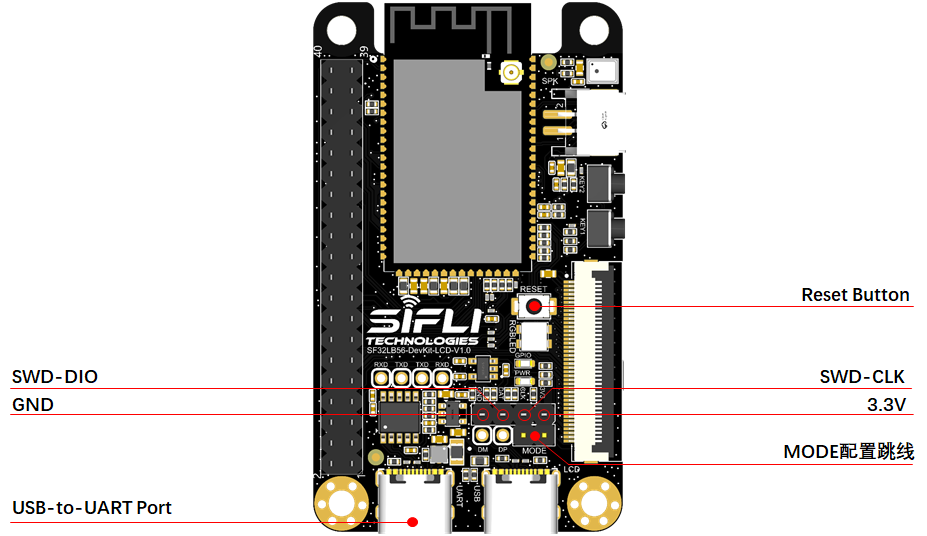
Sample Acquisition¶
Retail samples and small quantities can be purchased directly from Taobao. For bulk orders, please send an email to sales@sifli.com or contact customer service on Taobao for sales information. Open source contributors can apply for free samples by joining QQ group 674699679 for communication.